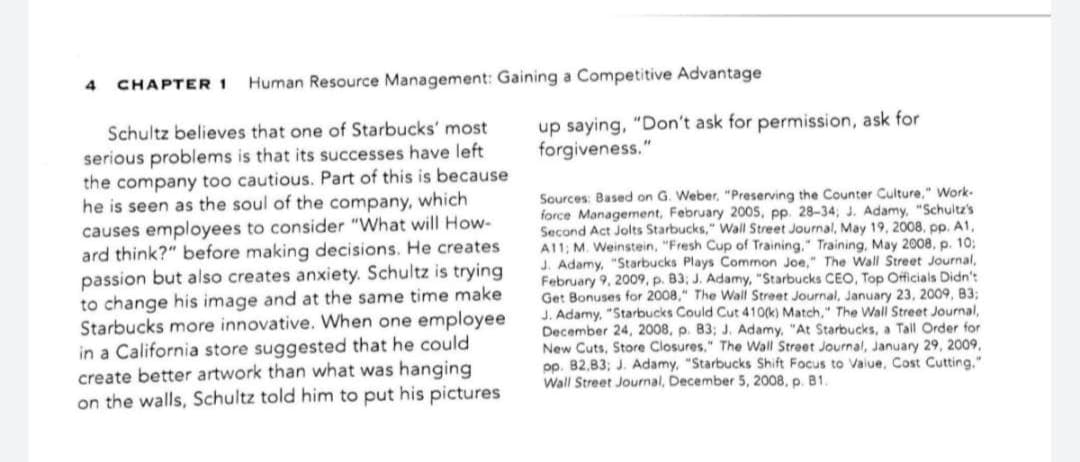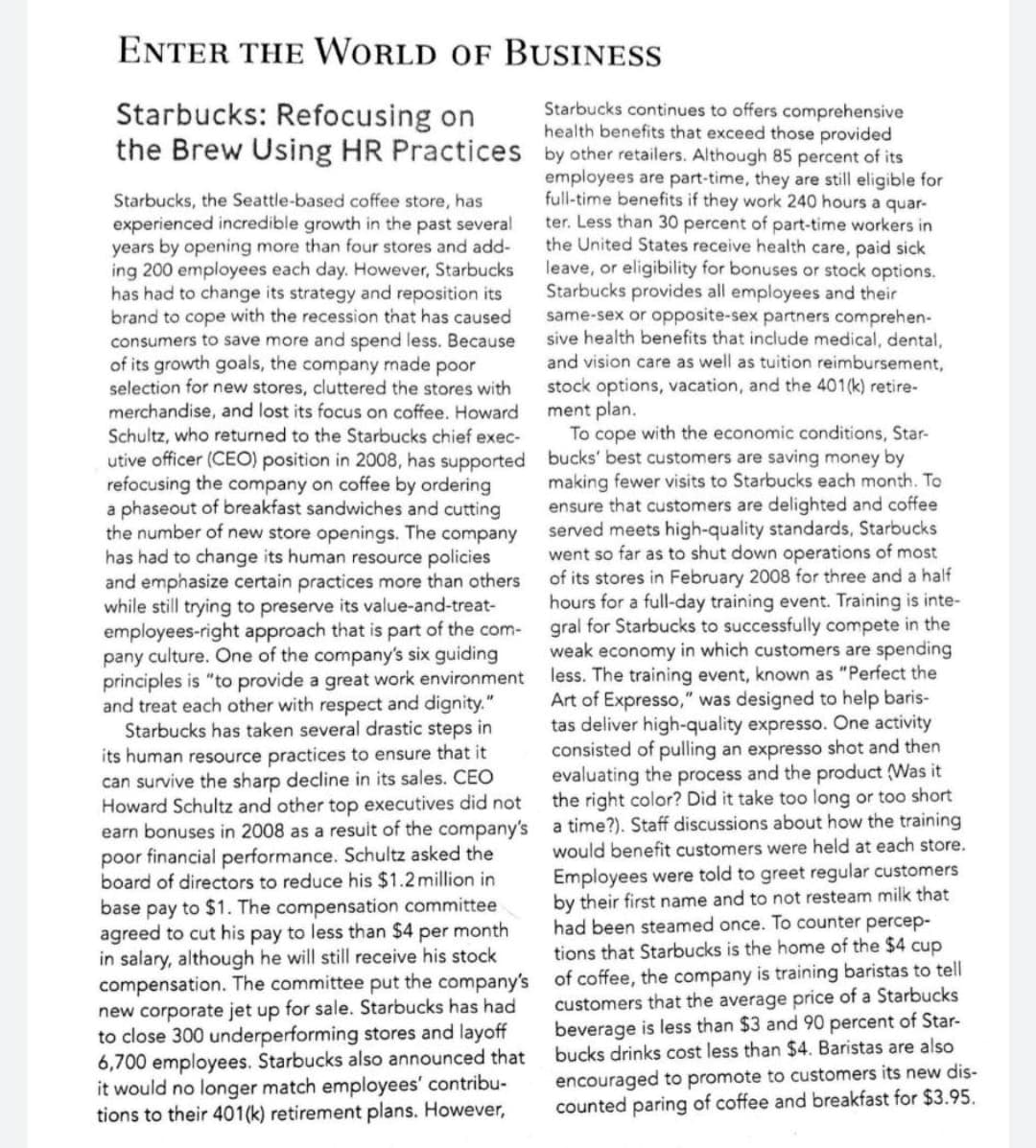Identify 2 additional human resources practices that may help Starbucks to compete better in markets
Identify 2 additional human resources practices that may help Starbucks to compete better in markets
Management, Loose-Leaf Version
13th Edition
ISBN:9781305969308
Author:Richard L. Daft
Publisher:Richard L. Daft
Chapter12: Managing Human Talent
Section: Chapter Questions
Problem 1EE
Related questions
Question
Identify 2 additional human resources practices that may help Starbucks to compete better in markets

Transcribed Image Text:CHAPTER 1
Human Resource Management: Gaining a Competitive Advantage
up saying, "Don't ask for permission, ask for
forgiveness."
Schultz believes that one of Starbucks' most
serious problems is that its successes have left
the company too cautious. Part of this is because
he is seen as the soul of the company, which
causes employees to consider "What will How-
ard think?" before making decisions. He creates
passion but also creates anxiety. Schultz is trying
to change his image and at the same time make
Starbucks more innovative. When one employee
in a California store suggested that he could
create better artwork than what was hanging
on the walls, Schultz told him to put his pictures
Sources: Based on G. Weber, "Preserving the Counter Culture," Work-
force Management, February 200s, pp. 28-34; J. Adamy, "Schultz's
Second Act Jolts Starbucks," Wall Street Journal, May 19, 2008, pp. A1,
A11; M. Weinstein, "Fresh Cup of Training," Training, May 2008, p. 103;
J. Adamy, "Starbucks Plays Common Joe," The Wall Street Journal,
February 9, 2009, p. B3; J. Adamy, "Starbucks CEO, Top Officials Didn't
Get Bonuses for 2008," The Wall Street Journal, January 23, 2009, 83:
J. Adamy, "Starbucks Could Cut 410(k) Match," The Wall Street Journal,
December 24, 2008, p. B3; J. Adamy, "At Starbucks, a Tall Order for
New Cuts, Store Closures." The Wall Street Journal, January 29, 2009,
pp. 82,83; J. Adamy, "Starbucks Shift Focus to Vaiue, Cost Cutting."
Wall Street Journal, December 5, 2008, p. B1.

Transcribed Image Text:ENTER THE WORLD OF BUSINESS
Starbucks: Refocusing on
the Brew Using HR Practices by other retailers. Although 85 percent of its
Starbucks continues to offers comprehensive
health benefits that exceed those provided
employees are part-time, they are still eligible for
full-time benefits if they work 240 hours a quar-
ter. Less than 30 percent of part-time workers in
the United States receive health care, paid sick
leave, or eligibility for bonuses or stock options.
Starbucks provides all employees and their
same-sex or opposite-sex partners comprehen-
sive health benefits that include medical, dental,
and vision care as well as tuition reimbursement,
stock options, vacation, and the 401(k) retire-
ment plan.
To cope with the economic conditions, Star-
Starbucks, the Seattle-based coffee store, has
experienced incredible growth in the past several
years by opening more than four stores and add-
ing 200 employees each day. However, Starbucks
has had to change its strategy and reposition its
brand to cope with the recession that has caused
consumers to save more and spend less. Because
of its growth goals, the company made poor
selection for new stores, cluttered the stores with
merchandise, and lost its focus on coffee. Howard
Schultz, who returned to the Starbucks chief exec-
utive officer (CEO) position in 2008, has supported bucks' best customers are saving money by
refocusing the company on coffee by ordering
a phaseout of breakfast sandwiches and cutting
the number of new store openings. The company
has had to change its human resource policies
and emphasize certain practices more than others
while still trying to preserve its value-and-treat-
employees-right approach that is part of the com-
pany culture. One of the company's six guiding
principles is "to provide a great work environment less. The training event, known as "Perfect the
and treat each other with respect and dignity."
Starbucks has taken several drastic steps in
its human resource practices to ensure that it
can survive the sharp decline in its sales. CEO
Howard Schultz and other top executives did not
earn bonuses in 2008 as a resuit of the company's a time?). Staff discussions about how the training
poor financial performance. Schultz asked the
board of directors to reduce his $1.2million in
base pay to $1. The compensation committee
agreed to cut his pay to less than $4 per month
in salary, although he will still receive his stock
compensation. The committee put the company's of coffee, the company is training baristas to tell
new corporate jet up for sale. Starbucks has had
to close 300 underperforming stores and layoff
6,700 employees. Starbucks also announced that
it would no longer match employees' contribu-
tions to their 401(k) retirement plans. However,
making fewer visits to Starbucks each month. To
ensure that customers are delighted and coffee
served meets high-quality standards, Starbucks
went so far as to shut down operations of most
of its stores in February 2008 for three and a half
hours for a full-day training event. Training is inte-
gral for Starbucks to successfully compete in the
weak economy in which customers are spending
Art of Expresso," was designed to help baris-
tas deliver high-quality expresso. One activity
consisted of pulling an expresso shot and then
evaluating the process and the product (Was it
the right color? Did it take too long or too short
would benefit customers were held at each store.
Employees were told to greet regular customers
by their first name and to not resteam milk that
had been steamed once. To counter percep-
tions that Starbucks is the home of the $4 cup
customers that the average price of a Starbucks
beverage is less than $3 and 90 percent of Star-
bucks drinks cost less than $4. Baristas are also
encouraged to promote to customers its new dis-
counted paring of coffee and breakfast for $3.95.
Expert Solution
This question has been solved!
Explore an expertly crafted, step-by-step solution for a thorough understanding of key concepts.
Step by step
Solved in 2 steps

Recommended textbooks for you

Management, Loose-Leaf Version
Management
ISBN:
9781305969308
Author:
Richard L. Daft
Publisher:
South-Western College Pub

Management, Loose-Leaf Version
Management
ISBN:
9781305969308
Author:
Richard L. Daft
Publisher:
South-Western College Pub